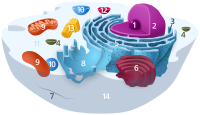
Photo from wikipedia
Mitochondria‐associated endoplasmic reticulum membranes (MAMs) regulate important cellular functions including calcium signaling, bioenergetics, and apoptosis during neurodevelopment and carcinogenesis, but its function in male reproduction and spermatogenesis remains enigmatic because… Click to show full abstract
Mitochondria‐associated endoplasmic reticulum membranes (MAMs) regulate important cellular functions including calcium signaling, bioenergetics, and apoptosis during neurodevelopment and carcinogenesis, but its function in male reproduction and spermatogenesis remains enigmatic because the field lacks a complete understanding of the proteome within testis MAMs. To better understand the biological processes and molecular functions of MAM in testes, a global mass spectrometry‐based proteomic evaluation of MAM proteins from human and mouse testes are reported here, respectively. The evaluation and analysis showed that the components of MAM were highly conserved not only between different species (human and mouse) but also between different tissues (testes and brains). Bioinformatics interrogation of these MAM protein catalogues uncovered that 815 new potential linkages specifically existed in mouse testes compared with mouse brains. In addition, a comparative analysis showed that 1347 proteins (account for ≈96.56%) were highly conservatively expressed in both human and mouse testis MAMs. Furthermore, functional analysis revealed that testis‐specific MAM proteins were related to spermatogenesis, male gamete generation, as well as sexual reproduction. The data identified, for the first time, numerous MAM proteins in mouse and human testes, which provide a possibility to define the relationship between testis MAM proteins and reproductive diseases.
Journal Title: PROTEOMICS
Year Published: 2018
Link to full text (if available)
Share on Social Media: Sign Up to like & get
recommendations!